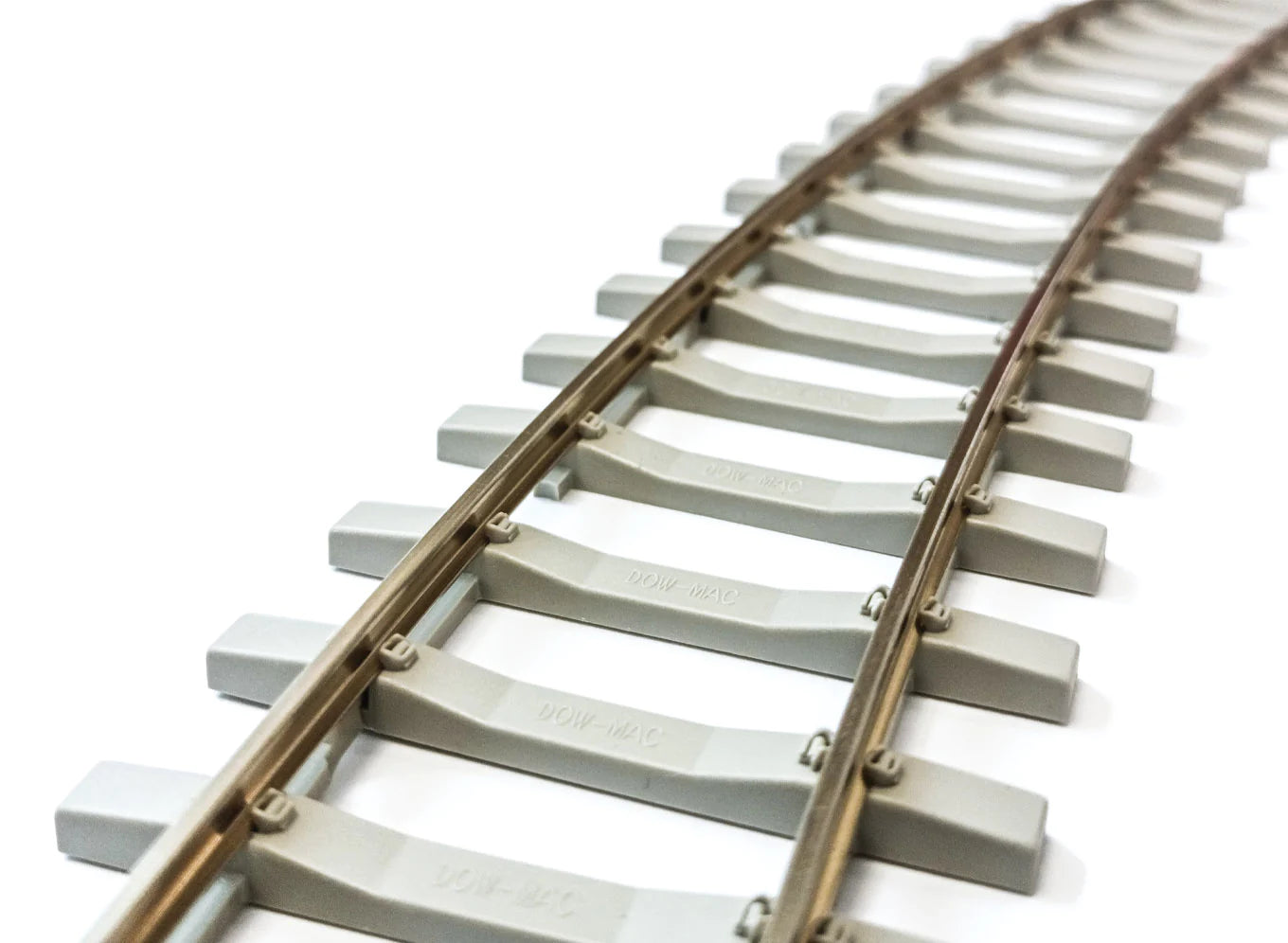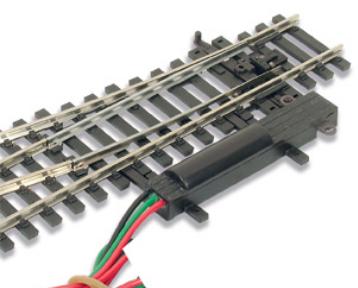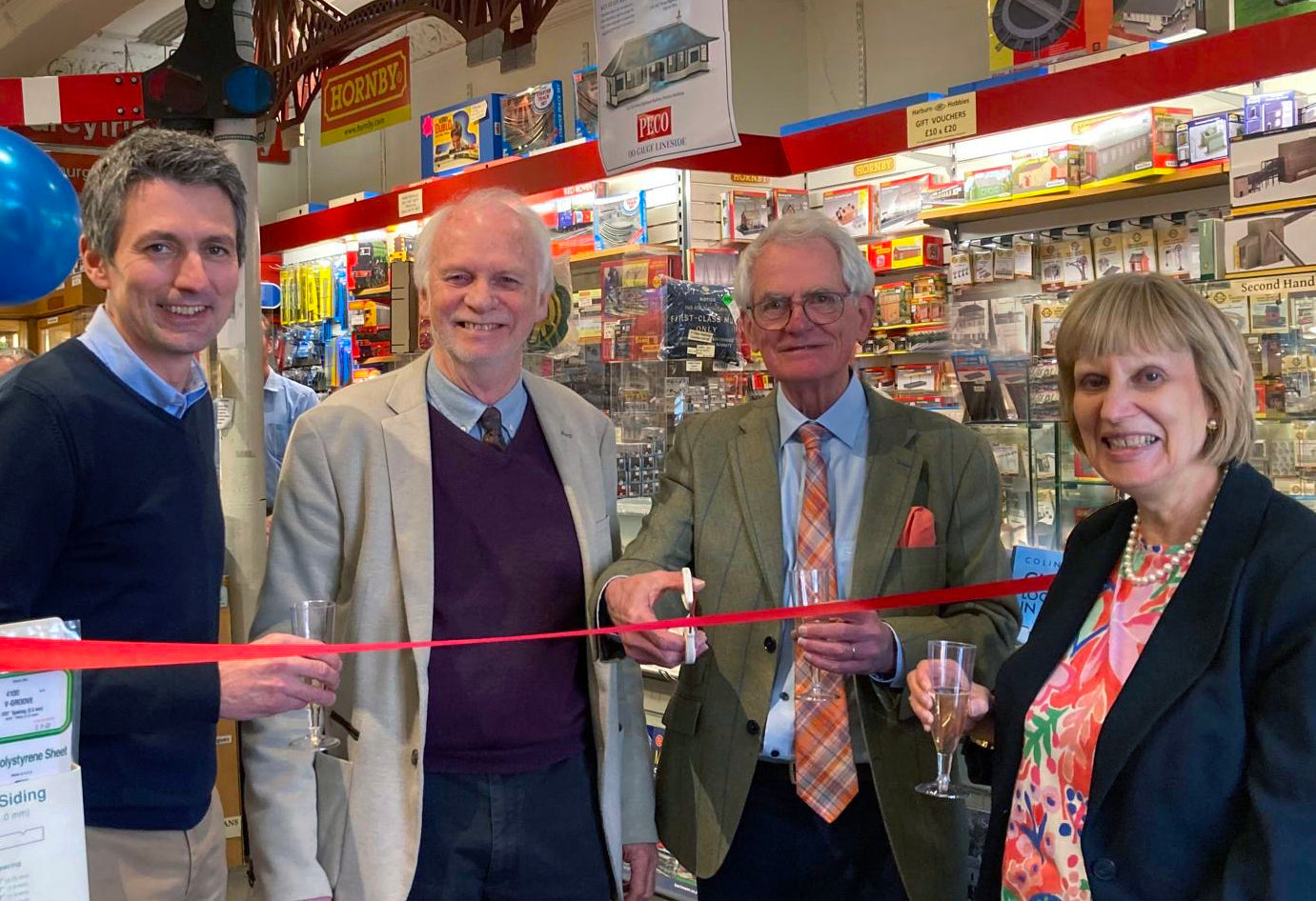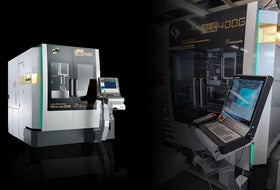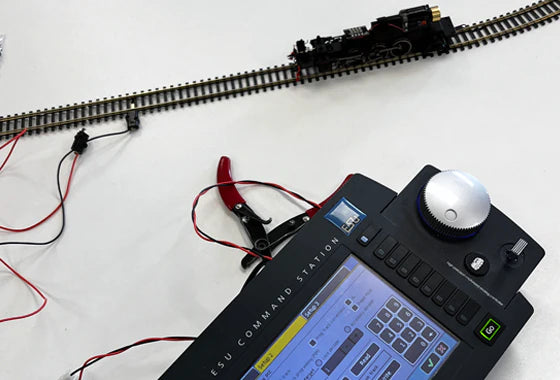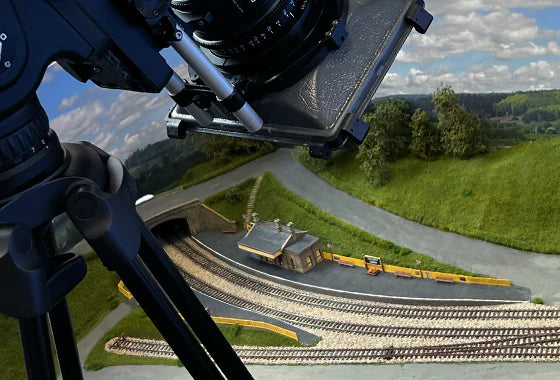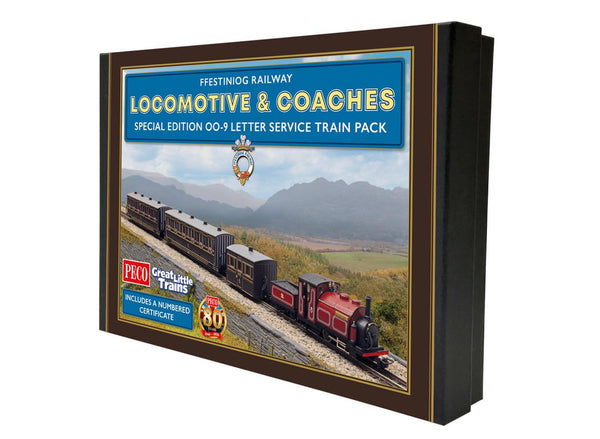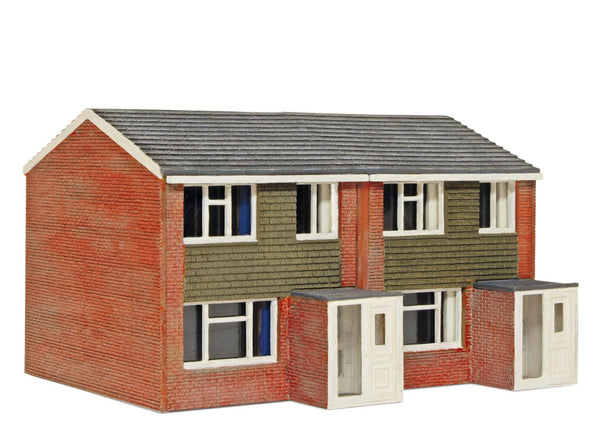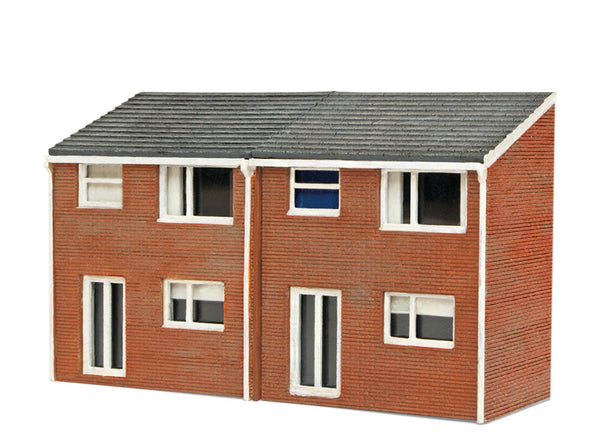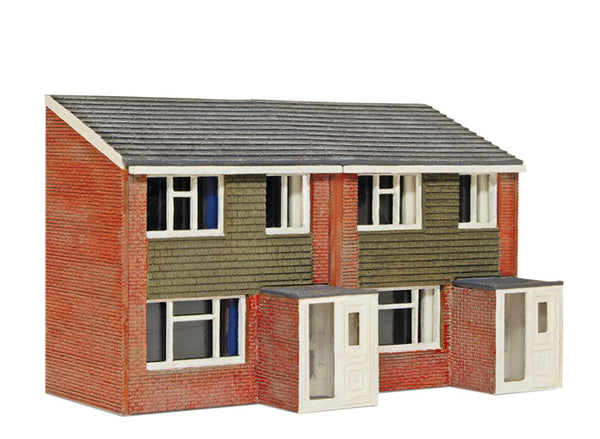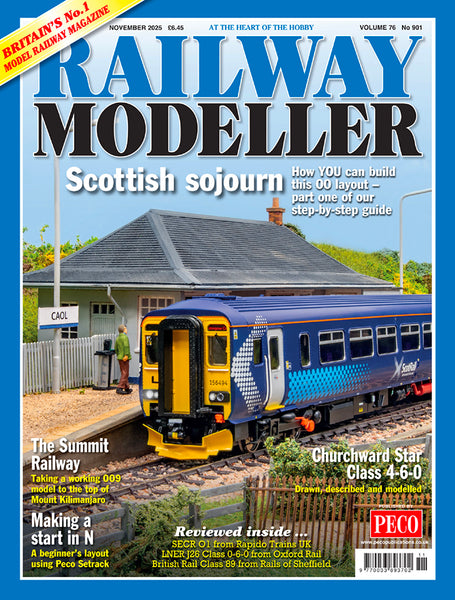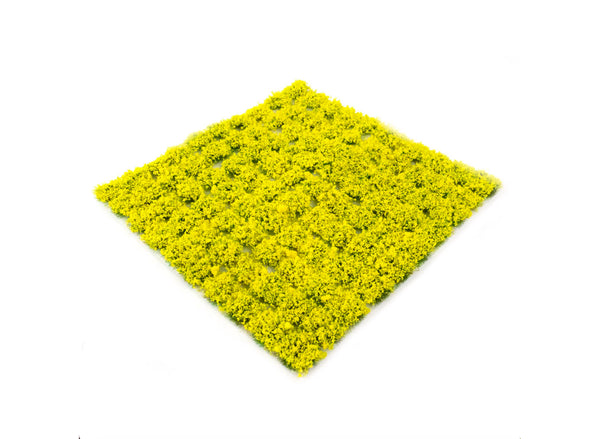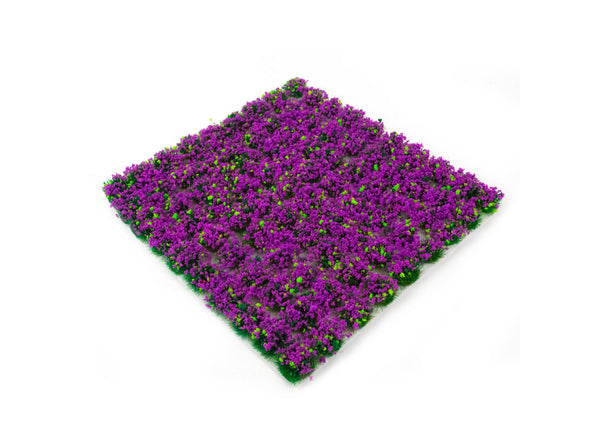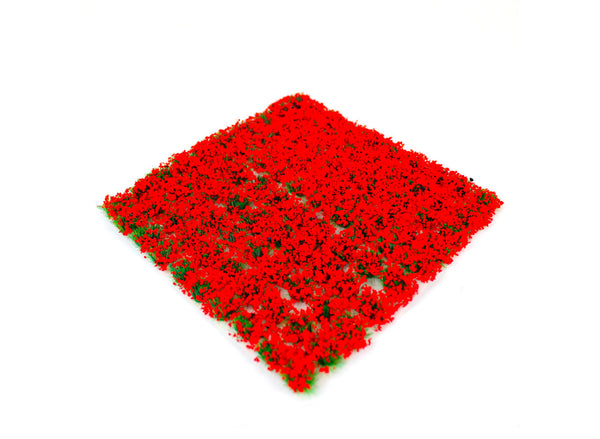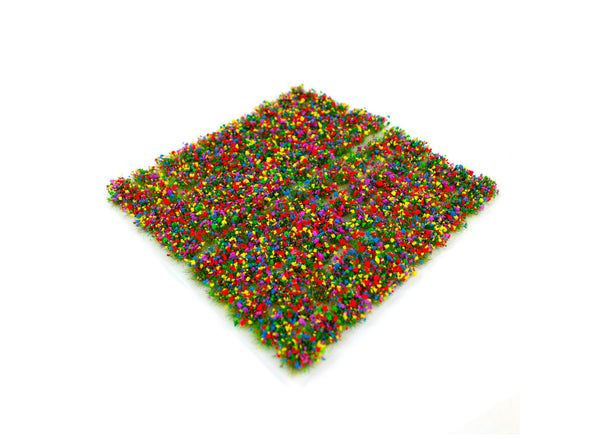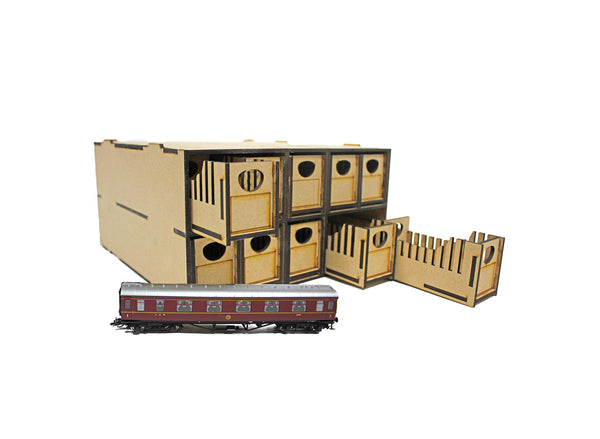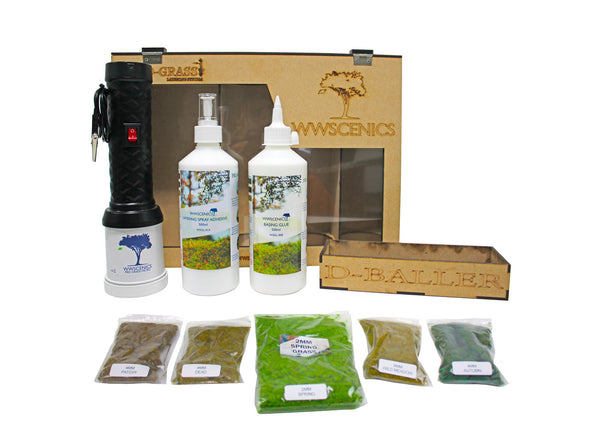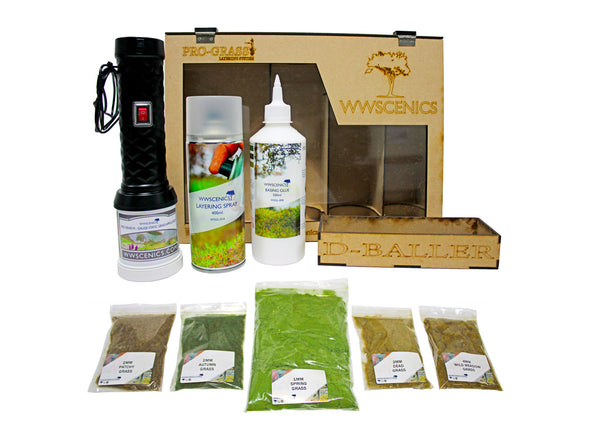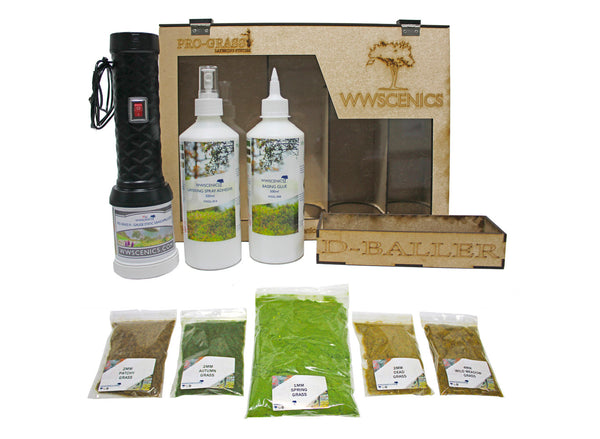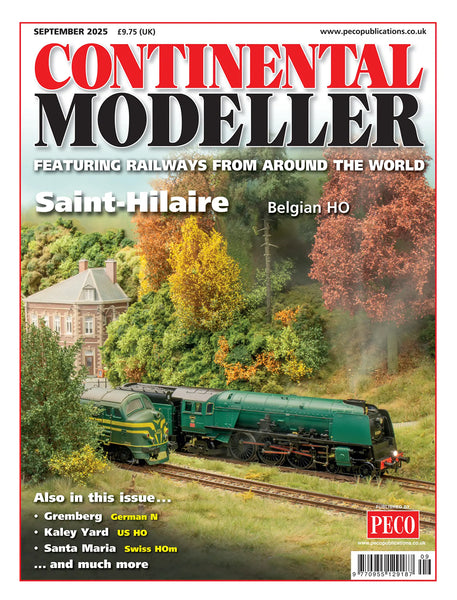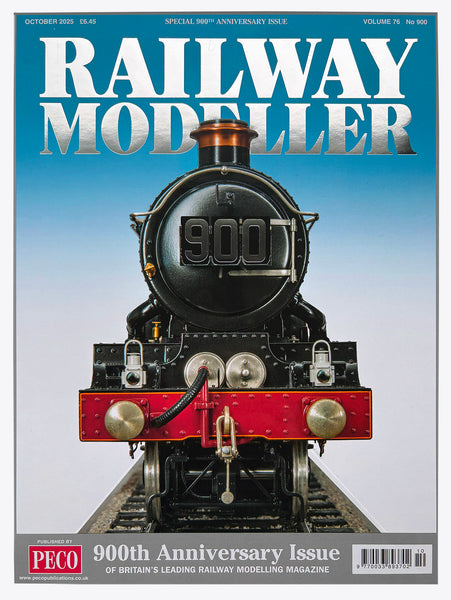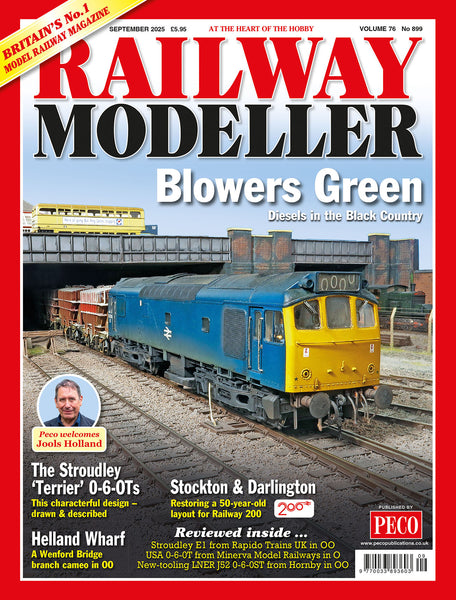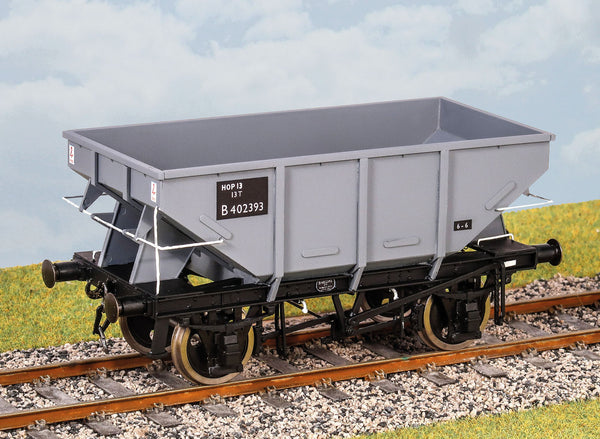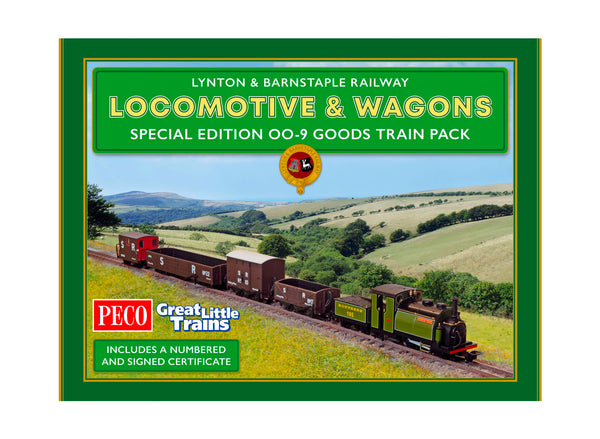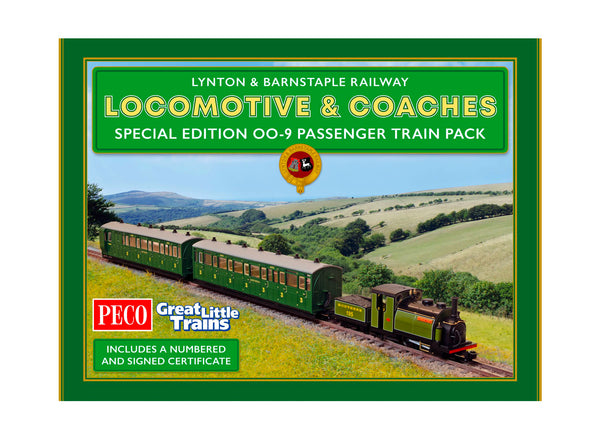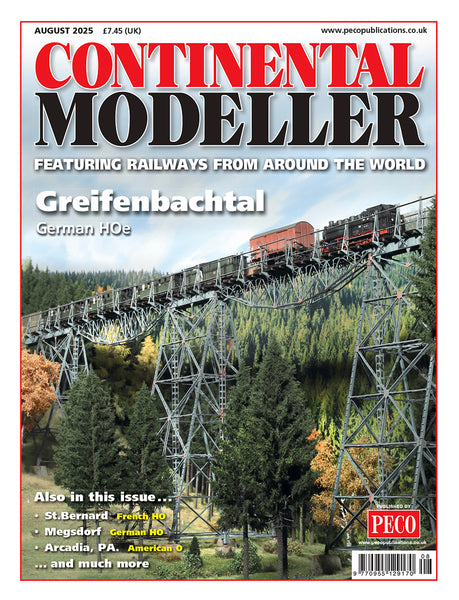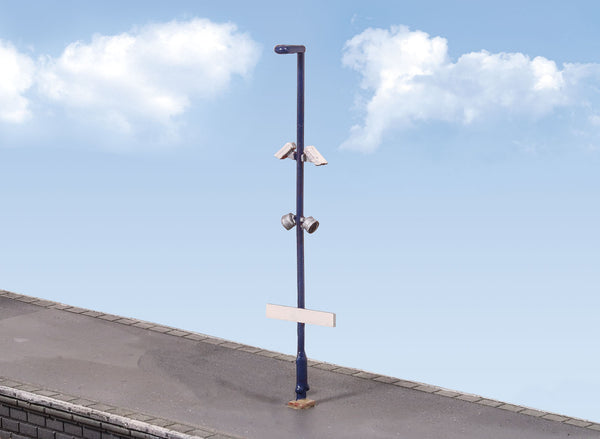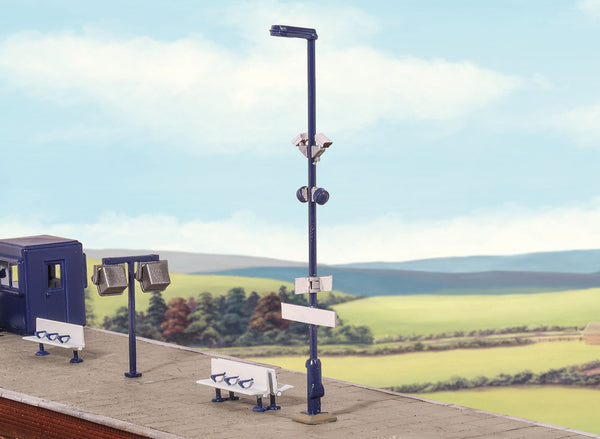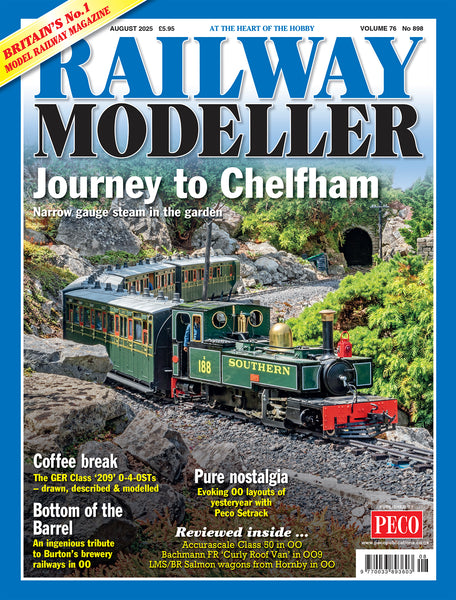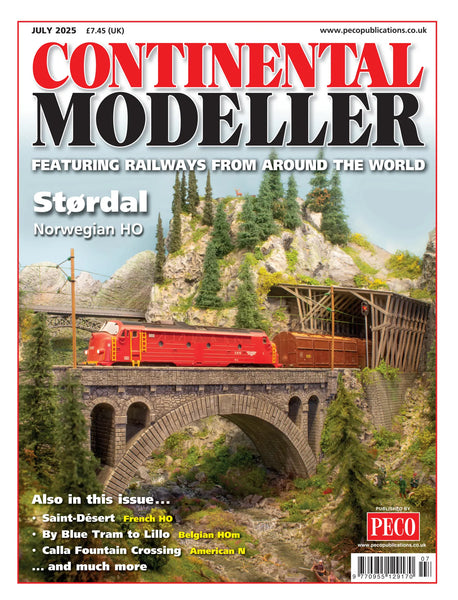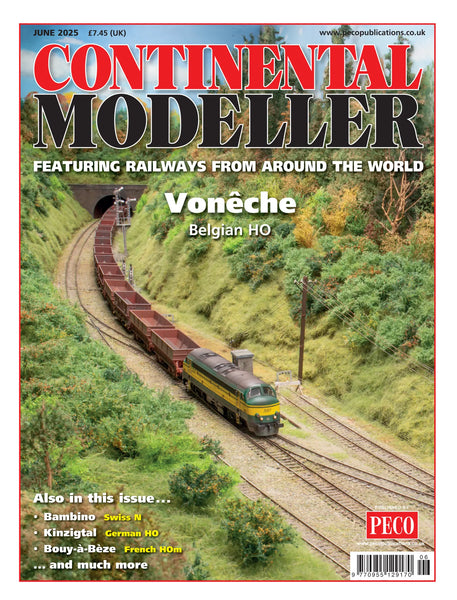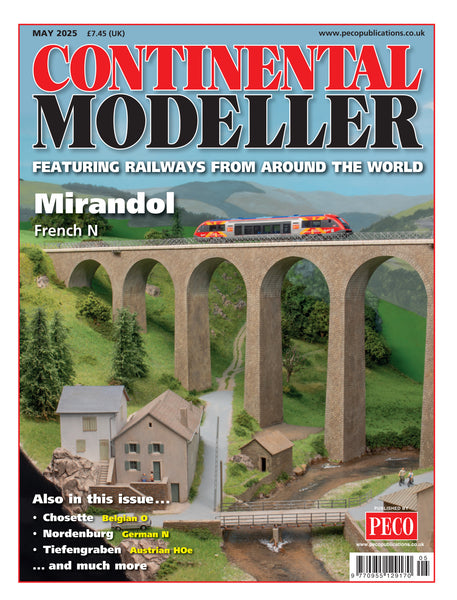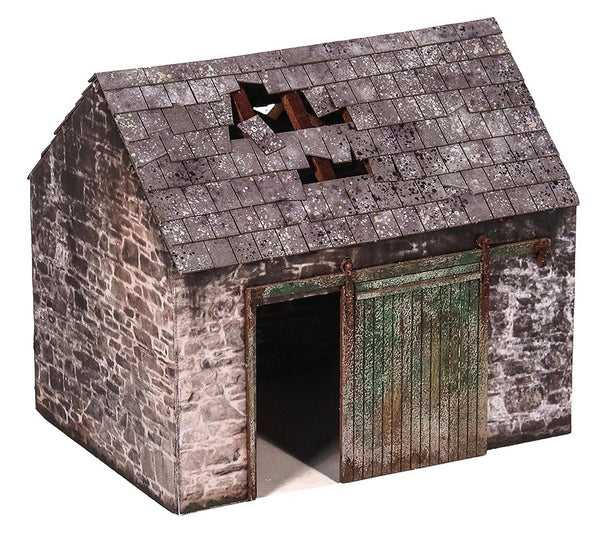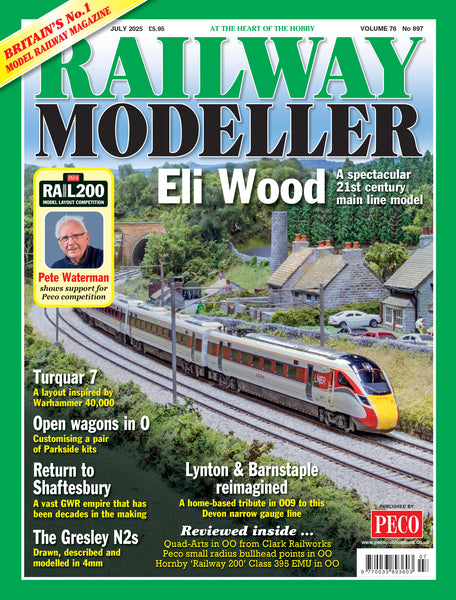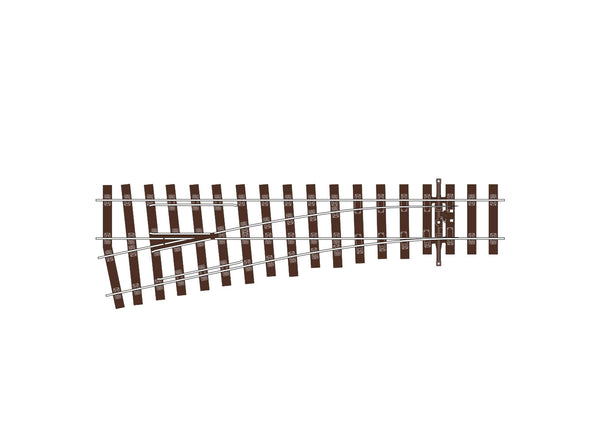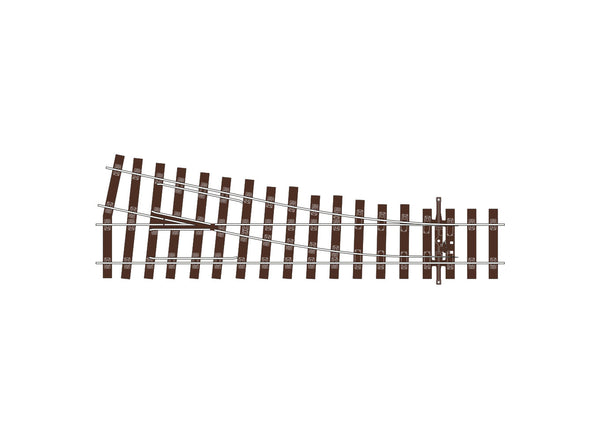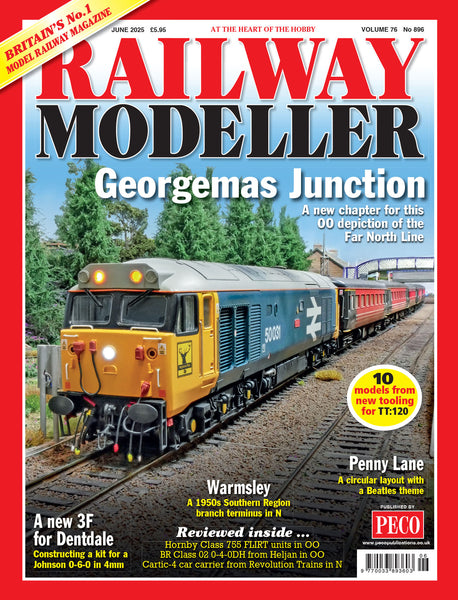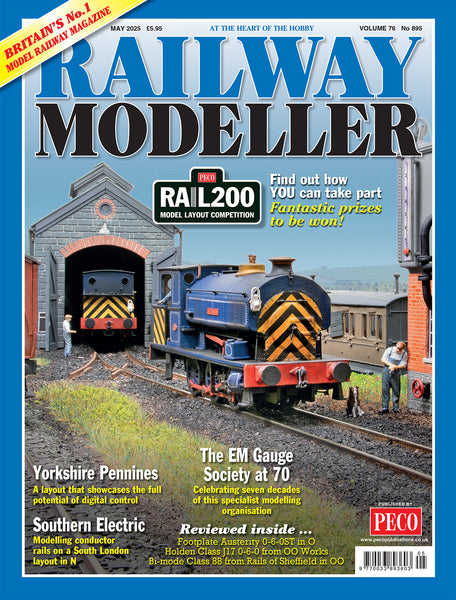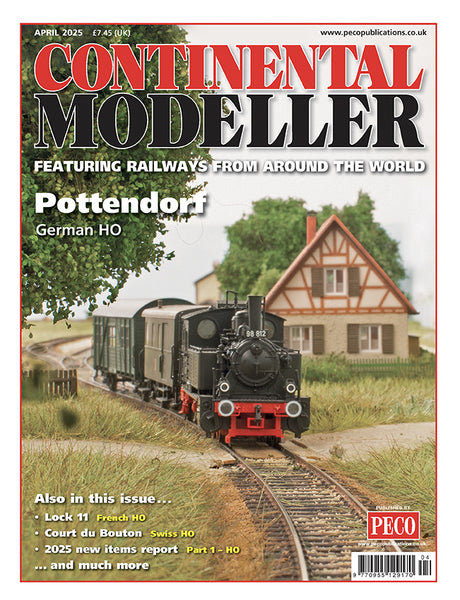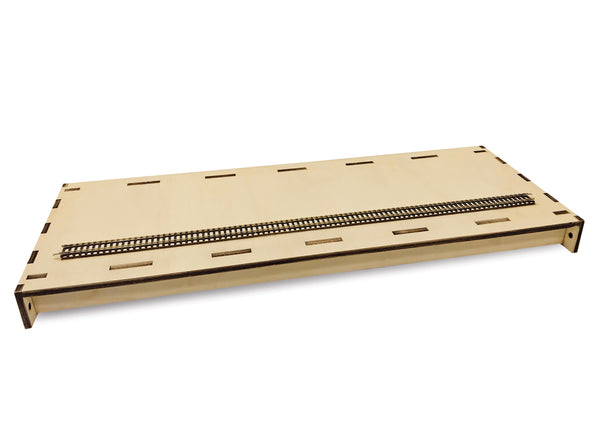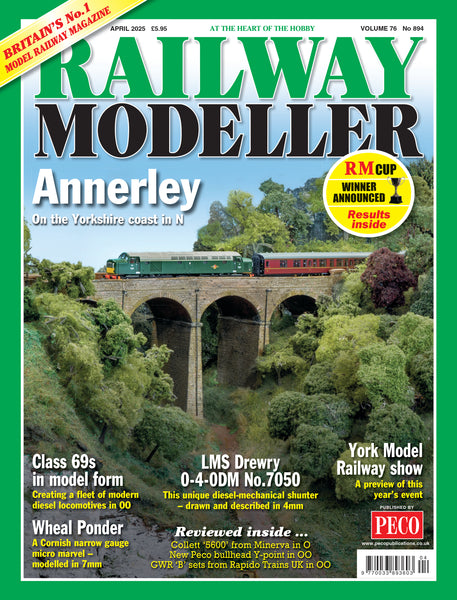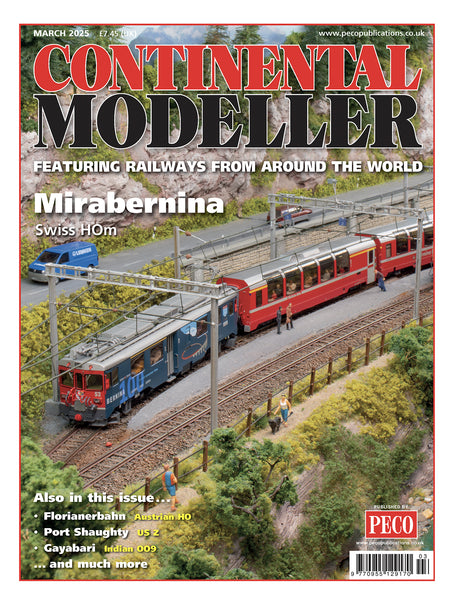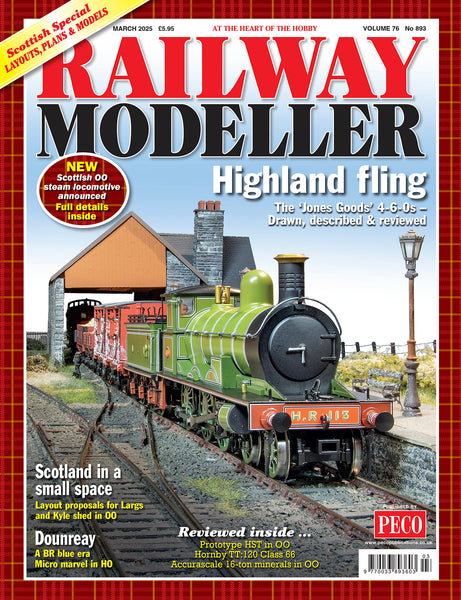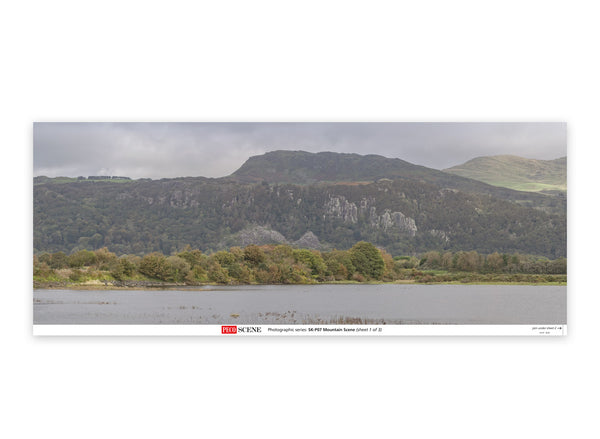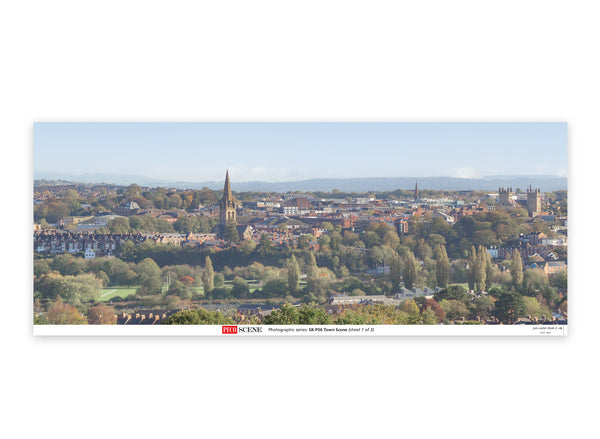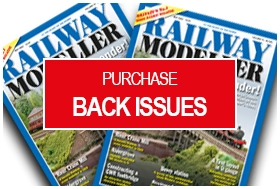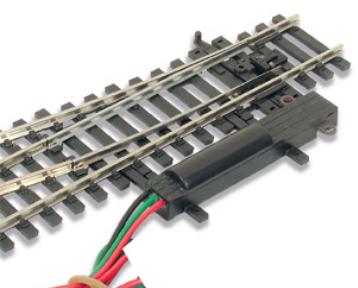BROWSE PECO PRODUCTS
Browse through our complete product portfolio.
2642 Products Found
CONTINENTAL MODELLER December 2025 Vol.49 No.12
In this months issue...
RAILWAY OF THE MONTH - PORT DE CROZON
A seaside terminus on the French metre gauge Réseau Breton modelled in 1:50.
PLAN OF THE MONTH - HEIDE
A wayside station between Antwerp in Belgium and Roosendaal in The Netherlands modelled in HO.
+PLUS!
All the latest news, reviews and layouts from around the world!
RAILWAY MODELLER December 2025 Vol.76 No.902
In the December edition of Railway Modeller, we announce the winners and runners-up in the Peco RAIL200 Model Layout Competition, which celebrated this year's 200th anniversary of the Stockton & Darlington Railway, and set participants the challenge of building a layout or diorama in a space of just 750mm x 305mm. The winning and runner-up layouts, together with other selected finalists, are featured in this issue and will be on display at the National Exhibition Centre for the National Festival of Railway Modelling on 22 & 23 November. Other features include the Diamond Jubilee of the London & North Eastern Railway Society, and the story of how a group of modellers re-created the Somerset & Dorset Joint Railway station of Sturminster Newton for display in that town's museum.
RAILWAY OF THE MONTH
Ryburn
A P4 model based on the Rishworth branch in Yorkshire, and set in the pre-Grouping era of the Lancashire & Yorkshire Railway.
PLAN OF THE MONTH
Ryecroft Arena
A modern era N gauge urban station in just 5' 7" x 2'; Bred Albin, an OO gauge Scottish terminus modelled in winter and set in the BR steam era; and Millfield, an OO9 narrow gauge layout built on a cardboard base. A suitably seasonal article also shows how a layout was built to run around the base of a Christmas tree!
PLUS ALL THE LATEST NEWS & REVIEWS...
2026 Railway Modeller Special (The Annual) (Copy)
The wonderful creative pastime of model railways is celebrated in the 2026.
Railway Modeller Special, produced by the publisher of Railway Modeller, the UK’s market-leading model railway title with the highest ABC audited readership., Railway Modeller remains unique in British model railway publishing, as it is part of a company that is long-associated with the industry, namely the world famous PECO model railway brand.
• Journey along the Somerset & Dorset – from Bath Green Park to Bournemouth West
• Thurlestone & Bullhouse – a celebration of pre-Grouping steam in OO
• Railways before 1825 – the story of rail evolution before Locomotion
• Smoke and mirrors – a model railway diorama for photographic subterfuge
• Along Alpine lines – riding the Swiss metre-gauge Rhaetian Railway
• Modelling tips and inspiration; manufacturer profile; and much, much more…
Special Edition OO-9 Letter Service Train Pack (Ffestiniog Railway)
The Ffestiniog Railway, located in North Wales, is the world’s oldest surviving independent railway company, founded in 1832. Originally built to transport slate from the quarries of Blaenau Ffestiniog to the port at Porthmadog, it was engineered with a unique narrow gauge of just 1 ft 11½ in (597 mm), ideal for winding through the rugged Snowdonia landscape. Innovative features included gravity-powered slate trains running downhill and horses hauling the wagons back uphill.
In the 1860s, steam locomotives were introduced, making the Ffestiniog the first narrow-gauge railway in the world to successfully use them. After declining slate demand led to closure in 1946, dedicated volunteers began restoring the line in the 1950s. Today, it runs as a popular heritage railway, linking Porthmadog to Blaenau Ffestiniog once again, and is celebrated for its pioneering engineering, scenic beauty, and remarkable preservation story.
These latest PECO train packs celebrate that legacy with attention to authenticity and a passion for detail.
Special Edition OO-9 Press Train Pack (Welsh Highland Railway)
The Ffestiniog Railway, located in North Wales, is the world’s oldest surviving independent railway company, founded in 1832. Originally built to transport slate from the quarries of Blaenau Ffestiniog to the port at Porthmadog, it was engineered with a unique narrow gauge of just 1 ft 11½ in (597 mm), ideal for winding through the rugged Snowdonia landscape. Innovative features included gravity-powered slate trains running downhill and horses hauling the wagons back uphill.
In the 1860s, steam locomotives were introduced, making the Ffestiniog the first narrow-gauge railway in the world to successfully use them. After declining slate demand led to closure in 1946, dedicated volunteers began restoring the line in the 1950s. Today, it runs as a popular heritage railway, linking Porthmadog to Blaenau Ffestiniog once again, and is celebrated for its pioneering engineering, scenic beauty, and remarkable preservation story.
These latest PECO train packs celebrate that legacy with attention to authenticity and a passion for detail.
1960s House Complete - L/Cut Kit
During the 1960s, British semi-detached houses reflected a period of post-war recovery and growing suburban prosperity. As Britain rebuilt from wartime damage and expanded its suburbs, demand for affordable family homes surged. Semi-detached houses became the ideal solution — cost-effective, spacious, and suited to modern lifestyles. Built mainly from brick or concrete with simple geometric designs, they often featured large windows, central heating, and private gardens. Unlike the ornate Victorian or interwar styles, 1960s semis embraced functionalism and minimal ornamentation, echoing modernist influences. Many were constructed as part of large housing estates on city outskirts, supported by improved road networks and rising car ownership. These homes symbolised optimism, mobility, and the shift toward suburban living, forming a lasting part of Britain’s mid-20th-century architectural identity.
- Laser cut wood kits with finely rendered detailing
- Each kit representing a typical 1960s style semi detached block of two houses, front elevation, rear elevation and complete building.
- Can be joined up to create a longer block, terrace.
- Front porch can be fitted as an optional extra
- Scope for further interior decoration (not provided)
- Complement our earlier releasee of Victorian Houses – kits NB306, NB307, NB308, also in N
-
Additional upsell products available form the ratio range such as:
- 300 Guttering and Downpipes
- 307 Chimneys
1960s House Back - L/Cut Kit
During the 1960s, British semi-detached houses reflected a period of post-war recovery and growing suburban prosperity. As Britain rebuilt from wartime damage and expanded its suburbs, demand for affordable family homes surged. Semi-detached houses became the ideal solution — cost-effective, spacious, and suited to modern lifestyles. Built mainly from brick or concrete with simple geometric designs, they often featured large windows, central heating, and private gardens. Unlike the ornate Victorian or interwar styles, 1960s semis embraced functionalism and minimal ornamentation, echoing modernist influences. Many were constructed as part of large housing estates on city outskirts, supported by improved road networks and rising car ownership. These homes symbolised optimism, mobility, and the shift toward suburban living, forming a lasting part of Britain’s mid-20th-century architectural identity.
- Laser cut wood kits with finely rendered detailing
- Each kit representing a typical 1960s style semi detached block of two houses, front elevation, rear elevation and complete building.
- Can be joined up to create a longer block, terrace.
- Front porch can be fitted as an optional extra
- Scope for further interior decoration (not provided)
- Complement our earlier releasee of Victorian Houses – kits NB306, NB307, NB308, also in N
-
Additional upsell products available form the ratio range such as:
- 300 Guttering and Downpipes
- 307 Chimneys
1960s House Front - L/Cut Kit
During the 1960s, British semi-detached houses reflected a period of post-war recovery and growing suburban prosperity. As Britain rebuilt from wartime damage and expanded its suburbs, demand for affordable family homes surged. Semi-detached houses became the ideal solution — cost-effective, spacious, and suited to modern lifestyles. Built mainly from brick or concrete with simple geometric designs, they often featured large windows, central heating, and private gardens. Unlike the ornate Victorian or interwar styles, 1960s semis embraced functionalism and minimal ornamentation, echoing modernist influences. Many were constructed as part of large housing estates on city outskirts, supported by improved road networks and rising car ownership. These homes symbolised optimism, mobility, and the shift toward suburban living, forming a lasting part of Britain’s mid-20th-century architectural identity.
- Laser cut wood kits with finely rendered detailing
- Each kit representing a typical 1960s style semi detached block of two houses, front elevation, rear elevation and complete building.
- Can be joined up to create a longer block, terrace.
- Front porch can be fitted as an optional extra
- Scope for further interior decoration (not provided)
- Complement our earlier releasee of Victorian Houses – kits NB306, NB307, NB308, also in N
-
Additional upsell products available form the ratio range such as:
- 300 Guttering and Downpipes
- 307 Chimneys
RAILWAY MODELLER November 2025 Vol.76 No.901
RAILWAY OF THE MONTH
Pentworth
Mark Butler spent three decades creating this exquisite model of a Great Western branch line terminus in N gauge, much of the scenery for which was inspired by the celebrated Vale Scene at Pendon Museum in Oxfordshire. The layout is set to appear at the Rail-Ex Taunton show this October.
PLAN OF THE MONTH
Making a start in OO-9
Using a Peco 009 Setrack starter set as his starting point, James Walker created this self-contained North Wales narrow gauge scene in just 100 x 75cm.
PLUS ALL THE LATEST NEWS & REVIEWS...
Daffodil Tufts 6mm x 103
- TUFTS – 100 x Daffodil Self-Adhesive Static Grass Tufts by War World Scenics
- SELF-ADHESIVE – Easy to use, just peel & stick where required
- COLOURS – Available in more than 30 different colours and styles
- LENGTHS – Available in 4mm, 6mm and 10mm lengths
- IDEAL – For representing bushes and wild or long grass on model railway layouts, miniature bases, wargame battleboards and model dioramas
Daffodil Tufts 4mm x 103
- TUFTS – 100 x Daffodil Self-Adhesive Static Grass Tufts by War World Scenics
- SELF-ADHESIVE – Easy to use, just peel & stick where required
- COLOURS – Available in more than 30 different colours and styles
- LENGTHS – Available in 4mm, 6mm and 10mm lengths
- IDEAL – For representing bushes and wild or long grass on model railway layouts, miniature bases, wargame battleboards and model dioramas
Heather Tufts 6mm x 103
- TUFTS – 100 x Heather Self-Adhesive Static Grass Tufts by War World Scenics
- SELF-ADHESIVE – Easy to use, just peel & stick where required
- COLOURS – Available in more than 30 different colours and styles
- LENGTHS – Available in 4mm, 6mm and 10mm lengths
- IDEAL – For representing bushes and wild or long grass on model railway layouts, miniature bases, wargame battleboards and model dioramas
Heather Tufts 4mm x 103
- TUFTS – 100 x Heather Self-Adhesive Static Grass Tufts by War World Scenics
- SELF-ADHESIVE – Easy to use, just peel & stick where required
- COLOURS – Available in more than 30 different colours and styles
- LENGTHS – Available in 4mm, 6mm and 10mm lengths
- IDEAL – For representing bushes and wild or long grass on model railway layouts, miniature bases, wargame battleboards and model dioramas
Poppy Tufts 6mm x 103
- TUFTS – 100 x Poppy Self-Adhesive Static Grass Tufts by War World Scenics
- SELF-ADHESIVE – Easy to use, just peel & stick where required
- COLOURS – Available in more than 30 different colours and styles
- LENGTHS – Available in 4mm, 6mm and 10mm lengths
- IDEAL – For representing bushes and wild or long grass on model railway layouts, miniature bases, wargame battleboards and model dioramas
Poppy Tufts 4mm x 103
- TUFTS – 100 x Poppy Self-Adhesive Static Grass Tufts by War World Scenics
- SELF-ADHESIVE – Easy to use, just peel & stick where required
- COLOURS – Available in more than 30 different colours and styles
- LENGTHS – Available in 4mm, 6mm and 10mm lengths
- IDEAL – For representing bushes and wild or long grass on model railway layouts, miniature bases, wargame battleboards and model dioramas
Mixed Flower Tufts 6mm x 103
- TUFTS – 100 x Mixed Flowers Self-Adhesive Static Grass Tufts by War World Scenics
- SELF-ADHESIVE – Easy to use, just peel & stick where required
- COLOURS – Available in more than 30 different colours and styles
- LENGTHS – Available in 4mm, 6mm and 10mm lengths
- IDEAL – For representing bushes and wild or long grass on model railway layouts, miniature bases, wargame battleboards and model dioramas
Mixed Flower Tufts 4mm x 103
- TUFTS – 100 x Mixed Flowers Self-Adhesive Static Grass Tufts by War World Scenics
- SELF-ADHESIVE – Easy to use, just peel & stick where required
- COLOURS – Available in more than 30 different colours and styles
- LENGTHS – Available in 4mm, 6mm and 10mm lengths
- IDEAL – For representing bushes and wild or long grass on model railway layouts, miniature bases, wargame battleboards and model dioramas
TT:120/OO-9 Loco Storage Box (10 Drawer)
- Durable Craftsmanship: Constructed from sturdy 3mm laser-cut MDF for reliable, long-lasting use.
- Customisable Drawers: 10 adjustable drawers designed to fit TT:120 and OO9 locomotives, wagons, trucks, or vehicles securely.
- Smooth Sliding System: Easy-access drawers with a smooth-sliding design make organizing and retrieving your models hassle-free.
- Label-Friendly Design: Each drawer features a front-facing label slot, offering quick identification of your collection.
- Stackable Convenience: Interlocking tabs allow multiple boxes to be securely stacked for scalable storage solutions.
- Protective Foam Inserts: Includes foam sheets to create custom inserts for extra protection, ensuring your locomotives and rolling stock remain safe.
Pro Grass Layering System (International)
- The definitive Pro Grass Layering System N Gauge starter kit by WWScenics.
- Contains a Pro Grass N-Gauge Micro Applicator, Basing Glue, Layering Spray, D-Baller tool and a selection of static grasses .
- Create realistic model scenery using the Pro Grass Layering System method, pioneered by WWScenics.
- Suitable for Beginners and Experts.
- Supplied in our own custom-made storage box, for secure and tidy storage.
N-Gauge Pro Grass Layering System (UK)
- The definitive Pro Grass Layering System N Gauge starter kit by WWScenics.
- Contains a Pro Grass N-Gauge Micro Applicator, Basing Glue, Layering Spray, D-Baller tool and a selection of static grasses .
- Create realistic model scenery using the Pro Grass Layering System method, pioneered by WWScenics.
- Suitable for Beginners and Experts.
- Supplied in our own custom-made storage box, for secure and tidy storage.
N-Gauge Pro Grass Layering System (International)
- The definitive Pro Grass Layering System N Gauge starter kit by WWScenics.
- Contains a Pro Grass N-Gauge Micro Applicator, Basing Glue, Layering Spray, D-Baller tool and a selection of static grasses .
- Create realistic model scenery using the Pro Grass Layering System method, pioneered by WWScenics.
- Suitable for Beginners and Experts.
- Supplied in our own custom-made storage box, for secure and tidy storage.
CONTINENTAL MODELLER October 2025 Vol.47 No.10
In this months issue...
RAILWAY OF THE MONTH - 21 RUE DES HAIES
Vincent Cleren depicts an industrial suburb in HO in which family connections inform certain structures. Built as a home layout, it has been successful at shows.
MITTELSTADT
A stop-over on a route through the mountains - Chris Bart describes his extensive digitally-controlled permanent home HO layout set in central Germany.
PLAN OF THE MONTH - BROKEN CREEK
Lee Wenham with a carefully detailed switching scene, expanded from a home layout to be portable for shows. It will be at the Uckfield exhibition this month.
+PLUS!
All the latest news, reviews and layouts from around the world!
RAILWAY MODELLER October 2025 Vol.76 No.900
RAILWAY OF THE MONTH
Bristol Templecombe
Nigel Smith describes this extensive model of a British Railways steam era Motive Power Depot in 7mm scale, which has been developed over a period of 24 years by members of Warley Model Railway Club. It is set to be one of the main exhibits at the organisation's next annual show at Statfold on 11 & 12 October
PLAN OF THE MONTH
Claremont
Pete Latham describes this small and self-contained N gauge layout, which depicts a BR freight yard and utilises older examples of ready-to-run models. The layout plan provides the basis of an ideal entry-level project for those who are both short of space and working to a budget.
PLUS ALL THE LATEST NEWS & REVIEWS...
CONTINENTAL MODELLER September 2025 Vol.47 No.9
In this months issue...
RAILWAY OF THE MONTH - SAINT-HILAIRE
Steven Deruytter presents his Belgian HO layout, a simple plan for exhibiting based on actual locations and unusually in an autumn setting.
SAINT AGUR
Small but satisfying - Ray O'Neill presents 766 his compact French HO exhibition layout which poses certain challenges for shunting.
PLAN OF THE MONTH - SANTA MARIA
Dan Spalding describes his Rhatische Bahn HOm layout, which depicts a wayside station with typical features on a line that was planned but never actually built.
+PLUS!
All the latest news, reviews and layouts from around the world!
RAILWAY MODELLER September 2025 Vol.76 No.899
RAILWAY OF THE MONTH
Buckhorn Weston
Maurice Lockwood describes how he created this extensive loft-based layout in 00 gauge, which plays host to a vast array of BR Southern Region steam-hauled services of the late 1950s to mid-1960s period.
PLAN OF THE MONTH
Island steam in TT:120
With PECO announcing a trio of laser-cut kits based on structures at Ventnor West, which will complement the forthcoming Hornby models of an Isle of Wight 'Terrier' and four-wheel coaches, modelling this station in 1:120 is set to become tantalisingly straightforward ...
PLUS ALL THE LATEST NEWS & REVIEWS...
O Gauge BR-LNER Steel Hopper Wagon Kit
The British Railways LNER 13-ton steel hopper wagon was based on an LNER design but produced in the early British Railways era between 1949 and 1953. It marked a step forward from earlier wooden-bodied wagons by using an all-steel, welded construction, which offered improved durability and reduced maintenance needs. The design reflected the LNER’s long-standing experience with mineral wagons, but was adapted for post-war production methods in BR workshops such as those at Shildon, Faverdale, and York.
Over 2,600 of these wagons were built, and they became a common sight in the North Eastern Region. This was partly because many goods yards in the area had coal-drop staithes, making the bottom-discharge hopper design especially efficient for unloading bulk materials. While they were primarily intended for transporting coal, the hoppers proved versatile and were later used to carry stone, sand, and other aggregates.
The 13-ton steel hopper was a reliable and workmanlike vehicle that served across the UK for several decades. Its robust construction meant it could withstand heavy use, and it became a mainstay of freight traffic in the post-war period. Although newer wagon designs eventually replaced them, some examples remained in service into the early 1980s, making them one of the longer-lived mineral wagon types of the mid-20th century.
Special Edition OO-9 Goods Train Pack
Inspired by one of Britain’s most beloved narrow-gauge railways – the Lynton & Barnstaple, these exclusive new packs feature the beautifully detailed KATO Large England locomotive “Exmoor Pony” paired with unique-liveried rolling stock – only available in these sets and not sold separately.
Each pack comes in a smart, collector-style presentation box, complete with custom packaging and a striking outer sleeve – perfect for displaying or gifting.
Special Edition OO-9 Passenger Train Pack
Inspired by one of Britain’s most beloved narrow-gauge railways – the Lynton & Barnstaple, these exclusive new packs feature the beautifully detailed KATO Large England locomotive “Exmoor Pony” paired with unique-liveried rolling stock – only available in these sets and not sold separately.
Each pack comes in a smart, collector-style presentation box, complete with custom packaging and a striking outer sleeve – perfect for displaying or gifting.
CONTINENTAL MODELLER August 2025 Vol.47 No.8
In this months issue...
RAILWAY OF THE MONTH - SAINT-BERNARD
Thomas Bossonet presents his popular French HO exhibition layout, a rural terminus in the steam era which includes many distinctive local features.
GREIFENBACHTALBRÜCKE
The late Jochen Klinger and Jens Petermann created an impressive HOe display showing what was once the highest narrow gauge railway bridge in Saxony.
PLAN OF THE MONTH - MEGSDORF
Southern Germany in the snow - Norman Raven describes his family's latest HO exhibition layout, named and presented in memory of his late wife.
+PLUS!
All the latest news, reviews and layouts from around the world!
Modern Platform Lamps
These Modern Platform Lamps kits represent the typical kind of lamp standard found, admittedly, not just on platforms, but along any street or thoroughfare. With optional attachments included, such as CCTV cameras, loudspeakers and station signs, these are very versatile kits for modellers. The N scale pack provides parts for 10 lamps.
Modern Platform Lamps
These Modern Platform Lamps kits represent the typical kind of lamp standard found, admittedly, not just on platforms, but along any street or thoroughfare. With optional attachments included, such as CCTV cameras, loudspeakers and station signs, these are very versatile kits for modellers in both scales. Produced mainly in plastic, with easy-to-assemble parts and clear instructions provided, the OO/HO scale kits have the added advantage of using brass tubing for the main posts, so give the option to be made operational (additional parts would need to be sourced).
RAILWAY MODELLER August 2025 Vol.76 No.898
RAILWAY OF THE MONTH
The Dial Hill Railway
David Stockwell recounts the childhood influences that led to him modelling the Southern Railway-operated 1' 111h" gauge Lynton & Barnstaple Railway in 16mm scale, complete with an impressive replica of the line's Chelfham Viaduct.
PLAN OF THE MONTH
Pure nostalgia!
Thomas Burnham proposes an intensive 00 gauge plan using Peco Setrack components, which seeks to rekindle the excitement of Hornby Dublo layouts from the 1950s and 1960s.
PLUS ALL THE LATEST NEWS & REVIEWS...
CONTINENTAL MODELLER July 2025 Vol.47 No.7
In this months issue...
RAILWAY OF THE MONTH - ST0RDAL
From Hell to Dovrefjell - ModelSpoorGroep Valkenswaard introduce their Norwegian HO exhibition layout, an imaginary location chosen to include typical features.
CJ @ 13
Emmanuel Nouaillier demonstrates more of his techniques for intricately detailed structure modelling.
PLAN OF THE MONTH - SAINT-DESERT
A wayside station on a former PLM secondary line - Regis Deroussin introduces his home HO layout, which manages to include a station, a junction, and an impressive viaduct, in a reasonable space.
+PLUS!
All the latest news, reviews and layouts from around the world!
CONTINENTAL MODELLER June 2025 Vol.47 No.6
In this months issue...
RAILWAY OF THE MONTH - VONECHE
On the Athus - Maas line: MSC De Kempen present their new Belgian HO exhibition layout, set in Epoch Ill-IV to allow steam and diesel traction.
BOUY-A-BEZE
A seaside town served by a metre gauge secondaire - MSC Het Spoor vzw introduce their HOm evocation of a French coastal light railway.
PLAN OF THE MONTH - KINZIGTAL
German HO in the loft - Ian David describes his layout, which has been developed in two stages.
+PLUS!
All the latest news, reviews and layouts from around the world!
CONTINENTAL MODELLER May 2025 Vol.47 No.5
In this months issue...
RAILWAY OF THE MONTH - POTTENDORF
IN THE CÉVENNES - passing through the Massif Central, a set of three linked French N scenes.
BYRHH
BYRHH – part 2: Emmanuel Nouaillier crafts a scene around – and within – a product promoting a famous French brand.
PLAN OF THE MONTH - ILLIUM
NORDERNBURG – a German N permanent layout.
+PLUS!
All the latest news, reviews and layouts from around the world!
SMS OO Derelict Barn
A versatile small barn/stores kit which can be assembled as a derelict or pristine building with a choice of wall finishes.
RAILWAY MODELLER July 2025 Vol.76 No.897
RAILWAY OF THE MONTH
Eli Wood
Eric Farragher constructed this exhibition layout, designed with a double track continuous run format, to run modern day passenger and freight workings through a rural landscape.
PLAN OF THE MONTH
A Plaster Mill
Clive Baker describes this compact EM gauge model, inspired by shunting activities at the plaster mill of J C Staton & Son, at Tutbury in Staffordshire.
PLUS ALL THE LATEST NEWS & REVIEWS...
OO Bullhead Small Radius Turnout - Left Hand
The PECO Streamline OO Bullhead track range has shaped up to be a very comprehensive system comprising flexible track, bullhead joiners, buffer stop, large radius, medium radius turnout, a crossing, double & single slips, Y turnouts and now Small Radius Turnouts. There's enough there already for modellers to build a truly authentic steam-to-diesel transition period layout.
- PECO Streamline OO Bullhead Small Radius Turnout, Unifrog
- Shares the same geometry as the existing Streamline Code 100, 75 flat bottom tracks systems
- Compatible with existing Bullhead system
- Uses standard SL-110 Code 75 rail joiner or the SL-114 Bullhead rail joiner
- Length 185mm
- Radius 610mm
- Frog angle 12 degrees
- Unifrog
- High quality nickel silver rail for all rail parts, for optimal electrical conductivity
- An excellent track component where space restrictions prevent standard turnouts being used.
OO Bullhead Small Radius Turnout - Right Hand
The PECO Streamline OO Bullhead track range has shaped up to be a very comprehensive system comprising flexible track, bullhead joiners, buffer stop, large radius, medium radius turnout, a crossing, double & single slips, Y turnouts and now Small Radius Turnouts. There's enough there already for modellers to build a truly authentic steam-to-diesel transition period layout.
- PECO Streamline OO Bullhead Small Radius Turnout, Unifrog
- Shares the same geometry as the existing Streamline Code 100, 75 flat bottom tracks systems
- Compatible with existing Bullhead system
- Uses standard SL-110 Code 75 rail joiner or the SL-114 Bullhead rail joiner
- Length 185mm
- Radius 610mm
- Frog angle 12 degrees
- Unifrog
- High quality nickel silver rail for all rail parts, for optimal electrical conductivity
- An excellent track component where space restrictions prevent standard turnouts being used.
RAILWAY MODELLER June 2025 Vol.76 No.896
RAILWAY OF THE MONTH
Barrihandle
Inspired by the late lain Rice's layout plan Gairloch, the Wirral & North Wales Model Railway Group created this fictional fishing port on the west coast of Scotland - complete with a boat that sails around the harbour. Alisdair Macdonald tells its story.
PLAN OF THE MONTH
Warmsley
Peter Johnston describes his latest N gauge exhibition layout, a Southern Region branch line terminus set in the picturesque 195Os England of Agatha Christie ...
PLUS ALL THE LATEST NEWS & REVIEWS...
RAILWAY MODELLER May 2025 Vol.76 No.895
RAILWAY OF THE MONTH
Splott
Paul Spencer describes how he constructed this 1980s diesel era layout, set against a Cardiff industrial backdrop and digitally operated. It will be appearing at the EM Gauge Society Spring show on 10 & 11 May.
PLAN OF THE MONTH
Competition Cameos
A selection of ideas in different scales for the PECO RAIL200 competition, with the challenge to build a layout or diorama on a baseboard of just 291h" x 12".
PLUS ALL THE LATEST NEWS & REVIEWS...
CONTINENTAL MODELLER April 2025 Vol.47 No.4
In this months issue...
RAILWAY OF THE MONTH - POTTENDORF
You cannot better a good idea: Tim Hale has revisited a favourite theme - a Bavarian branch in the Deutsche Bundesbahn period, modelled in HO.
LOCK 11
Jan van Munster presents his French HO exhibition layout, which has an unusual working feature inspired by the Vallee des Eclusiers in the Vosges.
PLAN OF THE MONTH - ILLIUM
On the Colorado 3' gauge: Mick Savage describes his fixed room-filling American Sn3 layout.
+PLUS!
All the latest news, reviews and layouts from around the world!
RAIL200 Competition Baseboard
METHOD OF ENTRY:
The first step in entering our exciting and new RAIL200 Competition is the purchase of the dedicated RAIL200 Competition Baseboard. Our bespoke baseboard is designed for both the Modular Competition (OO Scale) and Standalone Competition (Any Scale). For the Modular Competition, the supplied track MUST be used and placed as instructed. Other gauge track can be used elsewhere on the board, but must not interfere with the mainline of track, as this will be used to operate if the entry makes it to the finals. For the Standalone Competition, the supplied track MAY be used, and wherever on the board, if desired. No specific tools will be required to assemble the baseboard, but a PVA glue will be required.
Upon purchase of this baseboard, you'll be contacted automatically via email with a useful video guide, showing you how to assemble your baseboard, as well as details on how to submit your entry for judging, to be in with a chance of making the finals and hopefully winning!
A printed hard copy of these instructions, as well as printed entry form will also be included with the baseboard that is sent to you.
Enjoy your build and good luck!
For more information or enquiries please e-mail: rail200competition@peco.co
The competition entry page can be found here.
ABOUT THE RAIL200 COMPETITION
The RAIL200 Competition aims to celebrate two centuries of railway heritage by engaging both seasoned and novice modellers and of all ages. Participants do not need prior experience in railway modelling, making this an inclusive opportunity for anyone that would like to take part of try their hand in modelling. The competition features two distinct categories, allowing entrants to choose based on their interests and skills.
These are:
1. The Modular Competition: Participants are tasked with creating a layout using a OO gauge piece of track provided by PECO. Strict guidelines ensure compatibility among entries, enabling the finalists’ layouts to be linked-together into a larger, cohesive exhibition at a special venue, to be announced. Finalists will have their layouts assembled by PECO technicians and showcased to the public, with features in Railway Modeller magazine and prizes for winners and runners-up.
2.The Standalone Competition: This category allows modellers to craft a scenic display in any scale or gauge, focusing solely on scenic creativity and imaginative design. Dioramas are standalone pieces and are not required to be connected operationally with other layouts. Finalists will have their work displayed publicly and featured in Railway Modeller magazine, with prizes awarded to winners and runners-up.
To enter the RAIL200 Competition, participants are required to purchase a specially designed RAIL200 baseboard, which grants automatic entry into the competition, and will be posted to them along with instructions on how to assemble their baseboard, as well as how to register their entry online, or if preferred by submitting in the post . Entrants are required to send high-quality photographs of their completed layouts or dioramas by the submission deadline, in order to be considered for the final. An independent panel of judges will evaluate the entries, selecting finalists for exhibition and publication opportunities.
POSTAGE & PACKING
UK (Scotland, England, Wales, N.Ireland) - £6.00
UK (Highlands & Islands) - £30.00
Please note: We apologise for any higher than expected delivery charges but these are the exact and direct costs from the courier that we cannot change.
KEY DATES
Competition Opens: Monday 7th April 2025
Submission Deadline: Tuesday 30th September 2025
Please note: This competition is a UK-based competition only
RAILWAY MODELLER April 2025 Vol.76 No.894
RAILWAY OF THE MONTH
Annerley
In reality, the Hull to Scarborough line leaves the coast at Bridlington and heads north to Filey. But David Harrison chose to imagine how the route would have looked, had it continued along the coast to Flamborough Head.
PLAN OF THE MONTH
Leominster
This N gauge layout, being built by the Marches Model Railway Group, is due to go on public display in April, in the town whose station it depicts. Peter Dennis tells the story so far.
PLUS ALL THE LATEST NEWS & REVIEWS...
CONTINENTAL MODELLER March 2025 Vol.47 No.3
In this months issue...
RAILWAY OF THE MONTH - MIRABERNINA
On the Rhatische Bahn Bernina line - Eddy de Wilde has modelled a fictional but plausible location on the Swiss metre gauge in HOm.
PETENNE - Part 2
Robert Macchi continues the detailed account of his Italian HO DCC-controlled permanent layout.
PLAN OF THE MONTH - FALLERSTADT
Dave Harris introduces his new DCC-controlled German HO exhibition layout - a busy suburban station with trains, trams, and buses.
+PLUS!
All the latest news, reviews and layouts from around the world!
RAILWAY MODELLER March 2025 Vol.76 No.893
RAILWAY OF THE MONTH
Dallas
John Wise describes how he created this imagined portrayal of a Great North of Scotland Railway branch terminus, set in the 1950s.hard Lambert describes the background to this imagined main line station, which is set on the Oldham Loop line between Manchester Victoria and Rochdale, in former Lancashire & Yorkshire Railway territory.
PLAN OF THE MONTH
Scotland in a small space
Toby Jennings suggests two compact Scottish layout plans in 00 gauge, both suitable for the new Highland Railway 'Jones Goods' 4-6-0 from Rapido Tr
PLUS ALL THE LATEST NEWS & REVIEWS...
Mountain Range Photographic Backscene (3 Sheets)
Supplied in a square-section tube, the three separate sheets will match perfectly together to form a continuous run of 2400mm (95in), and reaching to a height of 333mm (13in).
Town Photographic Backscene (3 Sheets)
Supplied in a square-section tube, the three separate sheets will match perfectly together to form a continuous run of 2400mm (95in), and reaching to a height of 333mm (13in).
